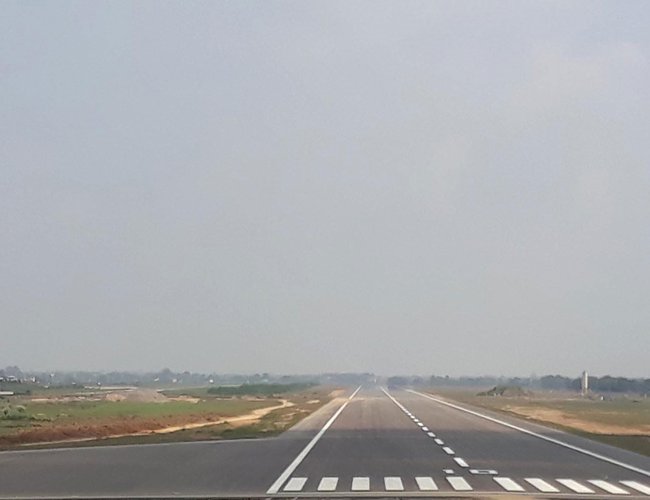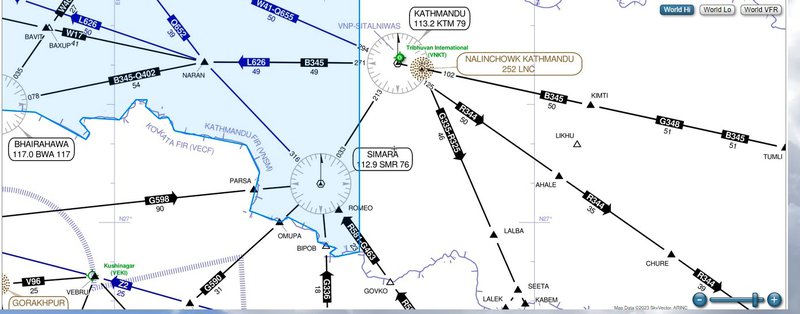
Nepali media has lately been speculating about the likely scenario of our side raising the nagging aviation related issues regarding airways and airports with the Indian side. The issue was in news eight years and Indian side, in keeping with their usual stance towards neighbours, have not bothered to address. This was despite the fact that solid assurance was given by the visiting Indian PM, and think it also figured in the joint communique issued then. And that India had agreed to open 21 Indian destinations for cross border air connectivity between two countries way back in 2006. As things seem to be not moving, we wonder whether it was “neighbours last”, not “first”, actually India pursues.
Airways are legitimate and recognized highways in the sky that passes through numerous countries binding them. And for conducting safe passage, it is critical to maintain a strict rule-based regime. The issue of vertical flight separation while cruising was cleverly solved by providing a designated flight level based on the flight course heading. As such, all high-level flights flying 0° to 179°, fly “odd” levels (FL290/310/330), and those in 180° to 359°, fly “even” levels (FL300/320/340). It is so simple that even two aircraft, say, flying identical courses of 179° and 180° will still not run into each other, as they will be at different flight levels. At another extreme, if two are on a "head-on" course they will still be a thousand feet apart, vertically.
Managing air traffic, as they come to land, is complex and demanding because aircraft will be getting progressively closer, both vertically and laterally in a relatively narrow area. Here the ATC rules supreme and has the final word. Ground-based visual aids like VASI/PAPI are not that reliable and often useless during poor visibility. To overcome this, there is a more reliable instrument landing system (ILS) that are much like other instrument screens in modern cockpit dashboard. ILS helps pilots to instantly know, and correct, if he has swung too far sideways or their profile is too high/low for landing. Put simply, ILS works on VHF frequencies that are beamed sideways, along the runway at 90 and 150 Hz, and another one that is angled up along the glide slope, but beamed at right angles to it. As we understand, India seems to have issues with ILS signals lobes transgressing into its territory from Bhairahawa/BWA ILS and the apparent main reason for not providing the expected “no objection” letter.
Assuming that the Indian side has a valid concern, even as a layman, I feel it is not normally possible to stop such low strength signal crossing over the border. With India being so sensitive about transgression, it must have found a novel way to block such signals at the border. Maybe that is why they have managed to run ILS at Agartala Airport (IXA) which sits jutting along the Bangladesh border. Understandably, the British-built airport was in existence before WWII and they certainly did not install ILS then. It was put in, only a few years ago, or after Bangladesh came into existence. Forget about the signal, the fact is no aircraft can ever land or take from Agartala without transgressing into Bangladesh territory. While Bhairahawa is much better placed and does not require flying over Indian territory while landing or after take-off, strangely Indian side still finds it unacceptable to let ILS run. For more on Agartala visit the following link: https://aim-india.aai.aero/eaip-v2//25-05-2017/eAIP/EC-AD-2.1VEAT-en-GB.pdf
Entry points:
The other issue of getting more airways entry points is even more critical for us. Presently we have two entry points from the Indian side. Of which, the one from Simara handles almost entire incoming flights to the extent it is choking. The other one is just a namesake via Bhadrapur that is only used by flights to/from Bhutan. But on the outbounds, there are five exit points with one in western Nepal near Mahendranagar and the remaining being via Bhairahawa, Simara, Janakpur and Biratnagar. This chronic entry/exit imbalance has created an unfair situation for Nepal. It is made worse by CAAN's inability to (1) fix taxiway-related issues at TIA and (2) make more flights/airlines comply with north-facing departures to make TIA a little more efficient.
As the distance between the Indian border and TIA is too short, it requires "every flight" heading to TIA from afar to coordinate with Indian controllers to get descent permission some 15-20 minutes before entering Nepal airspace. This is no less cumbersome for the Indian side to worry about descending Nepal-bound flights. They have tons of load to handle, due to ever-increasing domestic traffic, topped by regular transit and incoming/outgoing international movements. One way to get some relief will be increasing Nepal entry points by making all “exit only” airways to take both directions of traffic by making them two-way. This will allow all, if not most, Nepal-bound flights to descend or climb over Nepal comfortably, rather than congest the Indian sky.
The current entry system has become most unfair for Bhairahawa-bound flights. It is ludicrous to see traffic requiring to make a long detour to reach Simara before turning back west to land at BWA. This will also impact cross-border flights operating from Pokhara, will possibly not happen if the existing system remains stubbornly intact.
As we cannot choose our neighbours it is best to adjust with neighbours we have. There is no point in making a mountain out of a molehill, as they say in the west. But it is quite unbecoming to raise minor issues like signal transgression and put a foot down against entry point decongesting requests, even when there are far bigger issues needing attention. Besides, the above adage does not quite reflect the scale of distrust. The aviation-related issues have been so blown out of proportion that it is more like "making a mountain out of a sesame grain" (तिलको पहाड) as we say in Nepali. It will be better, for both sides, to have such nagging distractions resolved at the earliest.

He can be reached at harjyal@yahoo.com
- Tailwind Or No Tailwind
- Mar 18, 2024
- The Knockout Punch : Pokhara Crash Investigation Report
- Jan 05, 2024
- Kabadi’s Bi-cycle
- Aug 31, 2023
- Long Wait To Catch Something, Someday
- Aug 23, 2023
- Putting Foot Down
- May 13, 2023

















